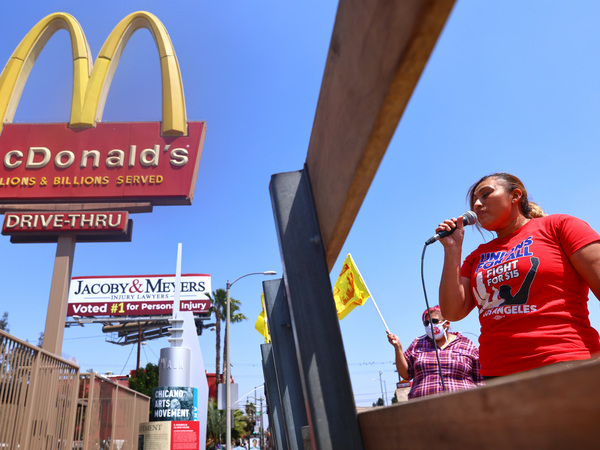
How anti-vaccine activists and the far right are trying to build a parallel economy
April 1, 2024
St. Paul’s 1 percent sales tax begins
April 1, 2024Some half a million workers in California are getting a big bump up in pay.
The state's minimum wage for fast-food employees jumps to $20 an hour on Monday, giving many a raise of 25% from just last week. The law affects some of the biggest restaurant chains — McDonald's, Pizza Hut, KFC, Subway, Starbucks — and local franchisees have raised alarms about the increase in labor costs.
Fast-food jobs are among the lowest-paying in the U.S. economy, where wages have been growing in recent years, after stagnating for decades. The workers are often women, immigrants and people of color; many live below the poverty line.
McDonald's worker Jaylene Loubett from Los Angeles points out that California is among the most expensive states in the country, and her city is one of the priciest in the state. Plus, inflation has meant higher cost of food and bills.
"Even though it's a big help, people need to realize that $20 compared to the cost of living in Los Angeles, it's still not enough to feel secure," says Loubett, 25, who's worked at McDonald's for six years.
She shares a one-bedroom apartment with her parents, who deal with medical issues. Ideally, Loubett hopes to use her raise to start saving toward a bigger home – or at least lessen the stress over expenses.
"It gives me a little bit more of a wiggle room," she says.
California's minimum wage for jobs outside fast food remains $16 an hour, though it's higher in some cities and counties. Employers paying under $20 an hour will likely face stiffer competition for workers.
Delivery drivers lose jobs and smoothies are pricier
California restaurant chain owners and franchisees say that higher labor costs will force them to raise prices, add automation, cut workers' hours or even close shop.
In December, Pizza Hut franchisees laid off hundreds of delivery drivers ahead of the wage hike and switched to apps like Uber Eats and Door Dash, which pushes more delivery fees onto customers.
Chains including Jack in the Box, Starbucks, McDonald's and Chipotle say they plan to raise prices more than they have already. The cost of eating out has stubbornly inched higher in the U.S. even as inflation has cooled elsewhere.
Brian Hom, who runs two franchise locations of Vitality Bowls, says the price of smoothies, salads and other items on his menu will increase 5% to 10% this week to offset the higher wages for his 30-some employees. Before Monday's raise, the minimum wage at his stores was $17.55.
"I'm happy that my employees are going to make more," Hom says. "But the impacts to the business are the concern… Will I be able to sustain the business?"
Other restaurant owners expect workers will be working fewer hours. That was the main side-effect of a minimum-wage hike in Seattle a decade ago, research suggests, with workers overall not losing jobs, but losing hours, though still generally earning more.
The rule applies to fast-food chains with at least 60 locations
California's pay hike is a result of a contentious deal struck by labor leaders, including the large Service Employees International Union, and fast-food companies.
The new wage law applies to fast-food chains with at least 60 locations nationwide, with exemptions for some bakeries and smaller outposts inside grocery stores, airports and other venues.
Under the new law, a new Fast Food Council was formed as part of the state's industrial relations department. The council, which includes both restaurant workers and owners, will develop standards, rules and regulations for the fast-food industry.
Broadly, California often sets the bar for many business decisions that other states later follow. Advocates hope something similar will happen with fast-food pay – spreading to other industries in the state and across the country.
In recent years, the battle for higher minimum wages has increasingly played out at the city, county and state levels as the federal minimum languishes at $7.25 an hour.
Copyright 2024 NPR. To see more, visit https://www.npr.org.





